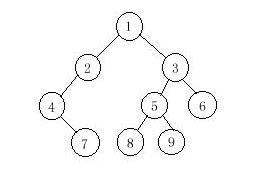Binary Tree Traversals
Time Limit: 1000/1000 MS (Java/Others) Memory Limit: 32768/32768 K (Java/Others)Total Submission(s): 5382 Accepted Submission(s): 2496
Problem Description
A binary tree is a finite set of vertices that is either empty or consists of a root r and two disjoint binary trees called the left and right subtrees. There are three most important ways in which the vertices of a binary tree can be systematically traversed
or ordered. They are preorder, inorder and postorder. Let T be a binary tree with root r and subtrees T1,T2.
In a preorder traversal of the vertices of T, we visit the root r followed by visiting the vertices of T1 in preorder, then the vertices of T2 in preorder.
In an inorder traversal of the vertices of T, we visit the vertices of T1 in inorder, then the root r, followed by the vertices of T2 in inorder.
In a postorder traversal of the vertices of T, we visit the vertices of T1 in postorder, then the vertices of T2 in postorder and finally we visit r.
Now you are given the preorder sequence and inorder sequence of a certain binary tree. Try to find out its postorder sequence.

In a preorder traversal of the vertices of T, we visit the root r followed by visiting the vertices of T1 in preorder, then the vertices of T2 in preorder.
In an inorder traversal of the vertices of T, we visit the vertices of T1 in inorder, then the root r, followed by the vertices of T2 in inorder.
In a postorder traversal of the vertices of T, we visit the vertices of T1 in postorder, then the vertices of T2 in postorder and finally we visit r.
Now you are given the preorder sequence and inorder sequence of a certain binary tree. Try to find out its postorder sequence.

Input
The input contains several test cases. The first line of each test case contains a single integer n (1<=n<=1000), the number of vertices of the binary tree. Followed by two lines, respectively indicating the preorder sequence and inorder sequence. You can assume
they are always correspond to a exclusive binary tree.
Output
For each test case print a single line specifying the corresponding postorder sequence.
Sample Input
9 1 2 4 7 3 5 8 9 6 4 7 2 1 8 5 9 3 6
Sample Output
7 4 2 8 9 5 6 3 1
大体题意:
给你二叉树的前序遍历和中序遍历,求出后序遍历。
思路:
前序遍历的方式 根 左 右, 所以前序遍历的第一个数字就是根,然后在中序遍历中找到根,根左边的数字都是root的左子树,根右边的数字都是root的右子树,然后在找到根,,,依次递归下去,可以用结构体建成一颗二叉树,然后建立完输出就是后序遍历。
#include<cstdio>
#include<cstring>
#include<algorithm>
using namespace std;
int n;
struct Node{
Node *left,*right;
int v;
};
int cnt = 0;
Node* build(int *pre,int *in,int len){
if (len == 0)return NULL;
Node* node = new Node;
node->v = *pre;
int rootindex = 0;
for (;rootindex < len ;++rootindex){
if (in[rootindex] == *pre)break;
}
node->left = build(pre+1,in,rootindex);
node->right = build(pre+rootindex+1,in+rootindex+1,len-1-rootindex);
if (cnt++)printf(" ");
printf("%d",node->v);
return node;
}
int main(){
// root = new Node;
int *pre,*in;
while(scanf("%d",&n) == 1 ){
cnt=0;
pre = new int[n];
in = new int[n];
for (int i = 0; i < n; ++i){
scanf("%d",&pre[i]);
}
for (int i = 0; i < n; ++i){
scanf("%d",&in[i]);
}
build(pre,in,n);
printf("\n");
}
return 0;
}










 本文详细解释了如何通过给定的二叉树的前序遍历和中序遍历序列,推导出对应的后序遍历序列。采用递归的方法构建二叉树,最终输出后序遍历结果。
本文详细解释了如何通过给定的二叉树的前序遍历和中序遍历序列,推导出对应的后序遍历序列。采用递归的方法构建二叉树,最终输出后序遍历结果。
















 255
255

 被折叠的 条评论
为什么被折叠?
被折叠的 条评论
为什么被折叠?








